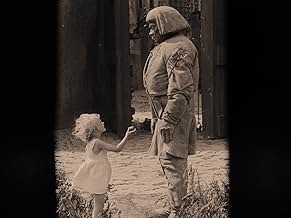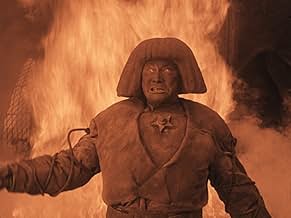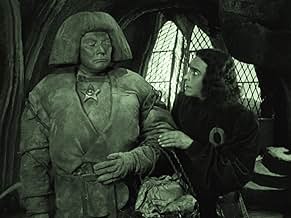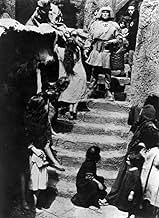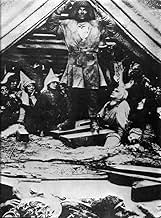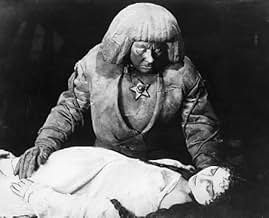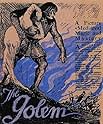PUNTUACIÓN EN IMDb
7,2/10
9,2 mil
TU PUNTUACIÓN
En la Praga del siglo XVI, un rabino crea un Golem, una criatura hecha de barro. Por medio de la brujería, hace que la criatura cobre vida para proteger a los judíos de Praga de ser persegui... Leer todoEn la Praga del siglo XVI, un rabino crea un Golem, una criatura hecha de barro. Por medio de la brujería, hace que la criatura cobre vida para proteger a los judíos de Praga de ser perseguidos.En la Praga del siglo XVI, un rabino crea un Golem, una criatura hecha de barro. Por medio de la brujería, hace que la criatura cobre vida para proteger a los judíos de Praga de ser perseguidos.
- Dirección
- Guión
- Reparto principal
- Premios
- 1 premio y 1 nominación en total
Hans Stürm
- Der Rabbi Jehuda, der Älteste der Gemeinde
- (as Hans Sturm)
Carl Ebert
- Temple Servant
- (sin acreditar)
Fritz Feld
- Jester
- (sin acreditar)
Loni Nest
- Ein kleines Mädchen
- (sin acreditar)
- …
Ursula Nest
- Little Girl
- (sin acreditar)
Dore Paetzold
- Des Kaisers Kebse
- (sin acreditar)
- …
Märte Rassow
- Kind
- (sin acreditar)
Reseñas destacadas
In 16th-century Prague, a Jewish rabbi (Albert Steinrück) creates a giant creature from clay, called the Golem, and using sorcery, brings the creature to life in order to protect the Jews of Prague from persecution.
Called "one of the most ambitious productions of the silent era" by Mike Mayo, the film is a blend of religion, astrology and black magic -- mixing Judaism with a conjuring of the demon Astaroth.
The film also has an interesting presentation of anti-Semitism, where the emperor accuses the Jews of killing Christ, among other things, and orders them to evacuate the ghetto. How did Germany in 1920 feel about the Jews? We now know how they felt a decade later, but was this hatred always there or invented by Hitler? If it existed, how did it translate to this film's reception by the German people?
Paul Wegener's face is a wealth of visions -- he manages to use his eyes in such a way that present the golem as simultaneously stoic and intensely emotional.
Others have pointed out that Karl Freund's camera is remarkably still for a man who would go on to be known for the most innovative camera techniques in film history (I dare say he is the greatest cinematographer who ever lived). Mayo says there is an "inventive use of extreme camera angles", but I did not notice. The lack of movement does not hinder the film, however.
Lee Price praises the film, saying the only fault of the film is "the inconsistency of the acting", though I did not find it distracting at all (even if the frightened faces of the extras are a bit extreme). Price calls the architecture of the film as influential (or more so) than the German Expressionism of "Caligari". He is not alone in this view: Ivan Butler makes a point to mention the "strange twisted buildings and crooked streets filled with steeple-hatted inhabitants", and Siegfried Kracauer singles out the "maze of crooked streets and stooped houses" devised by Professor Hans Poelzig.
If you are to see or own this film, I recommend the Kino DVD. Not only is the film cleaned up nicely, with a wonderful score and English title cards, but the supplements are beyond what one would expect from such an old film -- featurettes comparing this movie to "Faust" and the later "Le Golem". I enjoyed them.
Called "one of the most ambitious productions of the silent era" by Mike Mayo, the film is a blend of religion, astrology and black magic -- mixing Judaism with a conjuring of the demon Astaroth.
The film also has an interesting presentation of anti-Semitism, where the emperor accuses the Jews of killing Christ, among other things, and orders them to evacuate the ghetto. How did Germany in 1920 feel about the Jews? We now know how they felt a decade later, but was this hatred always there or invented by Hitler? If it existed, how did it translate to this film's reception by the German people?
Paul Wegener's face is a wealth of visions -- he manages to use his eyes in such a way that present the golem as simultaneously stoic and intensely emotional.
Others have pointed out that Karl Freund's camera is remarkably still for a man who would go on to be known for the most innovative camera techniques in film history (I dare say he is the greatest cinematographer who ever lived). Mayo says there is an "inventive use of extreme camera angles", but I did not notice. The lack of movement does not hinder the film, however.
Lee Price praises the film, saying the only fault of the film is "the inconsistency of the acting", though I did not find it distracting at all (even if the frightened faces of the extras are a bit extreme). Price calls the architecture of the film as influential (or more so) than the German Expressionism of "Caligari". He is not alone in this view: Ivan Butler makes a point to mention the "strange twisted buildings and crooked streets filled with steeple-hatted inhabitants", and Siegfried Kracauer singles out the "maze of crooked streets and stooped houses" devised by Professor Hans Poelzig.
If you are to see or own this film, I recommend the Kino DVD. Not only is the film cleaned up nicely, with a wonderful score and English title cards, but the supplements are beyond what one would expect from such an old film -- featurettes comparing this movie to "Faust" and the later "Le Golem". I enjoyed them.
This landmark film is one of the earliest surviving expressionist works, and it's art direction and photography-- while not as stunning as a film like Caligari-- is still extremely interesting with its misshapen sets and its use of light and shadow, and light within shadow. Unlike Caligari, the themes of this film were resonant long after its release, and perhaps still are today.
The Golem is a tolerance film that studies in depth the relationship between Jews and Christians in Prague. To his credit, Wegener refuses to impose stereotypes on either party, instead concentrating on individual characters and using mass characterizations only to highlight the themes of the film.
Unlike stereotypical Jews, rich guys with big noses who rub pennies together, the Jews of Prague are decidedly poor. It is interesting to note that the Jews are all dressed in black and with very few exceptions appear to be bent with age, a tribute to an aging and dying religion. However, they are also portrayed to be earnest and hard-working, with strong communal instincts. The Christians, by contrast, appear bright, shiny, and new. They are dressed in light colors and are young and wealthy, and outwardly appear to be God's new chosen. However, they are also portrayed as foolish bohemians who do not take God seriously. In the end, Christian innocents (and blonde-blue Aryan, coincidentally)are able to stop the Golem's rampage, but only because he allows it. The final shot shows the Star of David lying in the dust as the Jews come to carry their fallen champion back into the ghetto, closing the great door behind them and leaving you with a feeling that they are gone forever. However, it should be noted that the Golem is not only a champion to the Jews, but a symbol of revival.
Another interesting comparison in this film is that between the Golem and Jesus. Like man, the Golem is made of sand and clay, then given life by a supernatural force. They are both immaculate conceptions, with the Golem being motherless while Jesus is born to a virgin mother. Jesus in his time was a champion of the Jews, as is the Golem, and each of them rebelled against the wickedness of the authorities that governed them.
This open-ended presentation of the struggle of Christianity vs. Judaism is what makes this film truly great. I suspect that this relevant elevation above the ordinary is the reason for its survival, even though it is the third film of this series. The fact that Wegener was able to make a film that is so ambiguous is a credit to him considering the circumstances surrounding German film-making at the time.
Rabbi Loew is portrayed as a wise and heroic leader of the Jewish community, which lives in a winding ghetto. He creates the Golem for a noble cause-- to protect his people against eviction by the Christians--and in this cause succeeds after the Christian court is saved by the Golem from divine repudiation after laughing at Loew's presentation of the Old Testament. The creation scene is particularly interesting, not only in its visuals, but for the fact that in this scene Rabbi Loew wears white (for purity), yet performs a ceremony that is holy in nature yet seems like witchcraft. The Golem turns on him when he seeks to continue using the Golem's services for selfish purposes after the Golem has accomplished his mission.
Miriam and Loew's servant are portrayed quite differently. Miriam is a dark seductress who is unwittingly the cause of the Golem's destructive rampage. She is only saved from the hands of the Golem by another act of divine intervention, when the communal prayer of the Jews in the streets of the ghetto results in her release. She usually dresses in dark colors. However, there is also a scene before her affair with Florian in which she wears white (purity of a different kind). Also notice how Florian carelessly twirls a flower when he delivers the edict to Rabbi Loew. This is a brief, but effective, example of his character and foreshadows things to come. Loew's servant is the only other young Jewish character in the film besides a few Jewish children in the street, and it is his revival of the Golem during his jealous rage against Florian that sets the Golem on his destructive path. Like Loew, he is unable to remove the Star of David from the Golem's chest once he begins to use the Golem for selfish gain. In the end, he shares a poignant moment with Miriam where they seek forgiveness and confidence about their actions.
The depth and attention to detail that Wegener shows as a director (and writer) in this film helps to place it among the great films in the brief history of cinema. It's message is particularly haunting considering the events of the next 25 years after its release.
The Golem is a tolerance film that studies in depth the relationship between Jews and Christians in Prague. To his credit, Wegener refuses to impose stereotypes on either party, instead concentrating on individual characters and using mass characterizations only to highlight the themes of the film.
Unlike stereotypical Jews, rich guys with big noses who rub pennies together, the Jews of Prague are decidedly poor. It is interesting to note that the Jews are all dressed in black and with very few exceptions appear to be bent with age, a tribute to an aging and dying religion. However, they are also portrayed to be earnest and hard-working, with strong communal instincts. The Christians, by contrast, appear bright, shiny, and new. They are dressed in light colors and are young and wealthy, and outwardly appear to be God's new chosen. However, they are also portrayed as foolish bohemians who do not take God seriously. In the end, Christian innocents (and blonde-blue Aryan, coincidentally)are able to stop the Golem's rampage, but only because he allows it. The final shot shows the Star of David lying in the dust as the Jews come to carry their fallen champion back into the ghetto, closing the great door behind them and leaving you with a feeling that they are gone forever. However, it should be noted that the Golem is not only a champion to the Jews, but a symbol of revival.
Another interesting comparison in this film is that between the Golem and Jesus. Like man, the Golem is made of sand and clay, then given life by a supernatural force. They are both immaculate conceptions, with the Golem being motherless while Jesus is born to a virgin mother. Jesus in his time was a champion of the Jews, as is the Golem, and each of them rebelled against the wickedness of the authorities that governed them.
This open-ended presentation of the struggle of Christianity vs. Judaism is what makes this film truly great. I suspect that this relevant elevation above the ordinary is the reason for its survival, even though it is the third film of this series. The fact that Wegener was able to make a film that is so ambiguous is a credit to him considering the circumstances surrounding German film-making at the time.
Rabbi Loew is portrayed as a wise and heroic leader of the Jewish community, which lives in a winding ghetto. He creates the Golem for a noble cause-- to protect his people against eviction by the Christians--and in this cause succeeds after the Christian court is saved by the Golem from divine repudiation after laughing at Loew's presentation of the Old Testament. The creation scene is particularly interesting, not only in its visuals, but for the fact that in this scene Rabbi Loew wears white (for purity), yet performs a ceremony that is holy in nature yet seems like witchcraft. The Golem turns on him when he seeks to continue using the Golem's services for selfish purposes after the Golem has accomplished his mission.
Miriam and Loew's servant are portrayed quite differently. Miriam is a dark seductress who is unwittingly the cause of the Golem's destructive rampage. She is only saved from the hands of the Golem by another act of divine intervention, when the communal prayer of the Jews in the streets of the ghetto results in her release. She usually dresses in dark colors. However, there is also a scene before her affair with Florian in which she wears white (purity of a different kind). Also notice how Florian carelessly twirls a flower when he delivers the edict to Rabbi Loew. This is a brief, but effective, example of his character and foreshadows things to come. Loew's servant is the only other young Jewish character in the film besides a few Jewish children in the street, and it is his revival of the Golem during his jealous rage against Florian that sets the Golem on his destructive path. Like Loew, he is unable to remove the Star of David from the Golem's chest once he begins to use the Golem for selfish gain. In the end, he shares a poignant moment with Miriam where they seek forgiveness and confidence about their actions.
The depth and attention to detail that Wegener shows as a director (and writer) in this film helps to place it among the great films in the brief history of cinema. It's message is particularly haunting considering the events of the next 25 years after its release.
Although this 1920 German silent does not really rank alongside the truly great silent films, it remains a fascinating oddity. Based on European Jewish folklore, it tells the story a Jewish community in Prague which is threatened with expulsion from the city. In an effort to protect his people, Rabbi Loew creates a man-like creature made of clay and uses it to impress the Emperor. Unfortunately, the magic backfires, and when the Golem falls into the hands of the Rabbi's perfidious assistant disaster results.
Much of the film's charm is in its visual style. The sets by Hans Poelzig are a strange but cohesive mixture of medieval, nouveau, and surrealism, and the cinematography by legendary photography Karl Freund uses high contrast black and white to truly remarkable effect. The Poelzig-Freund combination would cast an extremely long shadow, and THE GOLEM would influence not only such German films as Fitz Lang's METROPOLIS but the entire cycle of 1930s American horror films that began with the 1931 Bela Lugosi Dracula.
Several plot devices and the look of the Golem, as played by Paul Wegener, would also prove particularly influential for director James Whale's famous 1932 FRANKENSTEIN. Whether or not Boris Karloff or make-up artist Jack Pierce knew the film is uncertain--but Whale, who was fond of German cinema, certainly did, and traces of THE GOLEM can be seen throughout his most famous works.
Over the past several decades a number of film historians have attempted to reinterpret THE GOLEM in light of the Holocaust. There may actually be a certain validity to this, for although the Jews are portrayed sympathetically they are very clearly outsiders, and their religion seems less like religion than witchcraft--and indeed Rabbi Loew might be said to practice black magic in bringing the Golem to life. This sense of social estrangement and religious stigmatism does seem indicative of the anti-Semitism that will ultimately explode into furnaces of Nazi Germany. All the same, it is worth noting that THE GOLEM is a fundamentally Jewish story to begin with, and it is perhaps best to think of it in those terms instead of using hindsight to impose modern meanings upon the film.
There are several home market releases of the film. While I have not seen it, I am told the Timeless Studios VHS release is weak; I have, however, seen the Gotham DVD release, and although there are some quality issues this inexpensive DVD is not at all bad. Still, my preference and recommendation is the Kino DVD. Unlike many Kino editions, it does not have anything significant in the way of bonuses, but the overall presentation is very fine and likely represents a best-possible presentation short of full digital restoration.
Much of the film's charm is in its visual style. The sets by Hans Poelzig are a strange but cohesive mixture of medieval, nouveau, and surrealism, and the cinematography by legendary photography Karl Freund uses high contrast black and white to truly remarkable effect. The Poelzig-Freund combination would cast an extremely long shadow, and THE GOLEM would influence not only such German films as Fitz Lang's METROPOLIS but the entire cycle of 1930s American horror films that began with the 1931 Bela Lugosi Dracula.
Several plot devices and the look of the Golem, as played by Paul Wegener, would also prove particularly influential for director James Whale's famous 1932 FRANKENSTEIN. Whether or not Boris Karloff or make-up artist Jack Pierce knew the film is uncertain--but Whale, who was fond of German cinema, certainly did, and traces of THE GOLEM can be seen throughout his most famous works.
Over the past several decades a number of film historians have attempted to reinterpret THE GOLEM in light of the Holocaust. There may actually be a certain validity to this, for although the Jews are portrayed sympathetically they are very clearly outsiders, and their religion seems less like religion than witchcraft--and indeed Rabbi Loew might be said to practice black magic in bringing the Golem to life. This sense of social estrangement and religious stigmatism does seem indicative of the anti-Semitism that will ultimately explode into furnaces of Nazi Germany. All the same, it is worth noting that THE GOLEM is a fundamentally Jewish story to begin with, and it is perhaps best to think of it in those terms instead of using hindsight to impose modern meanings upon the film.
There are several home market releases of the film. While I have not seen it, I am told the Timeless Studios VHS release is weak; I have, however, seen the Gotham DVD release, and although there are some quality issues this inexpensive DVD is not at all bad. Still, my preference and recommendation is the Kino DVD. Unlike many Kino editions, it does not have anything significant in the way of bonuses, but the overall presentation is very fine and likely represents a best-possible presentation short of full digital restoration.
At the beginning of the DvD's "scrapbook", there is a quote from Paul Wegener that says he never thought the Golem was an expressionist film. Watching it right after seeing Nosferatu, that statement becomes believable. Despite amazing sets that would have been at home in Caligari, in story, in acting, and in overall tone, The Golem is a much more naturalistic film. Watching it with my son, who is 16, he was struck by its uncomfortable prefiguring of Jewish persecution. I was impressed by the the scarcity of romantic cliches in the story. The golem itself is clearly the ancestor of the Frankenstein monster. Full of wonderful images and interesting as a predecessor of the Universal monster films, The Golem is also very entertaining as a story and as a piece of dramatic film making. Highly recommended.
When I see these old attempts at what amounted to a horror film back then, before my time and I'm an old duffer, I'm always struck at the marvelous Gothic quality wrought by the twisted buildings, the gnarled stairways, the open balconies and the weird angles of things such as doorways, arches, street, bridges and the like. The monstrosities are stark, hardly terrifying by today's CGIs and often terrifying their victims in an almost comical, stylized way. This marvelous film together with Nosferatu and The Cabinet of Dr. Caligari are marvelous pieces of art. There is an ageless quality to them that transcends the hoary and often corny plots and acting. Each must be taken as a whole because that product is always greater than the sum of their parts. Compare the magical Indian Love Call of Nelson Eddy and Jeanette MacDonald, two rather mainstream singers whose voices blend into something greater than either of their individual talents. So too it is, I contend, with these old Gothic classics. Horror? Hardly. But, their starkness and darkness with its twisted surroundings are still eerie and provoking.
¿Sabías que...?
- Curiosidades"Aemaet", the life-giving word which Rabbi Lowe compels from the spirit Astaroth is also reflected in the bolts of lightning at the end of the creation scene.
- PifiasThe story is set in the 16th Century. A prediction of doom is made based on the movements of Uranus, which was not discovered until 1781.
- Versiones alternativasThe 2002 Alpha Video DVD version runs for 101 minutes. This is not evident from the back of the Alpha Video DVD case, which wrongly lists the running time as only 85 minutes. It looks as if Alpha Video somehow got hold of the fullest version currently known - maybe even a complete version of the film, since there are no obvious gaps in the story.
- ConexionesEdited into People Who Die Mysteriously in Their Sleep (2004)
Selecciones populares
Inicia sesión para calificar y añadir a tu lista para recibir recomendaciones personalizadas
- How long is The Golem?Con tecnología de Alexa
Detalles
- Duración1 hora 16 minutos
- Color
- Mezcla de sonido
- Relación de aspecto
- 1.33 : 1
Contribuir a esta página
Sugerir un cambio o añadir el contenido que falta


